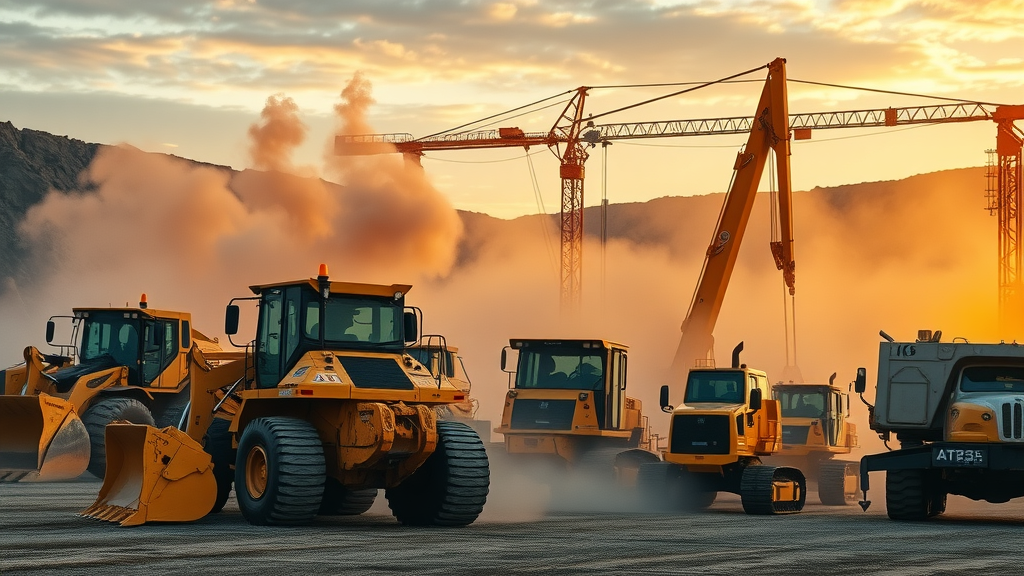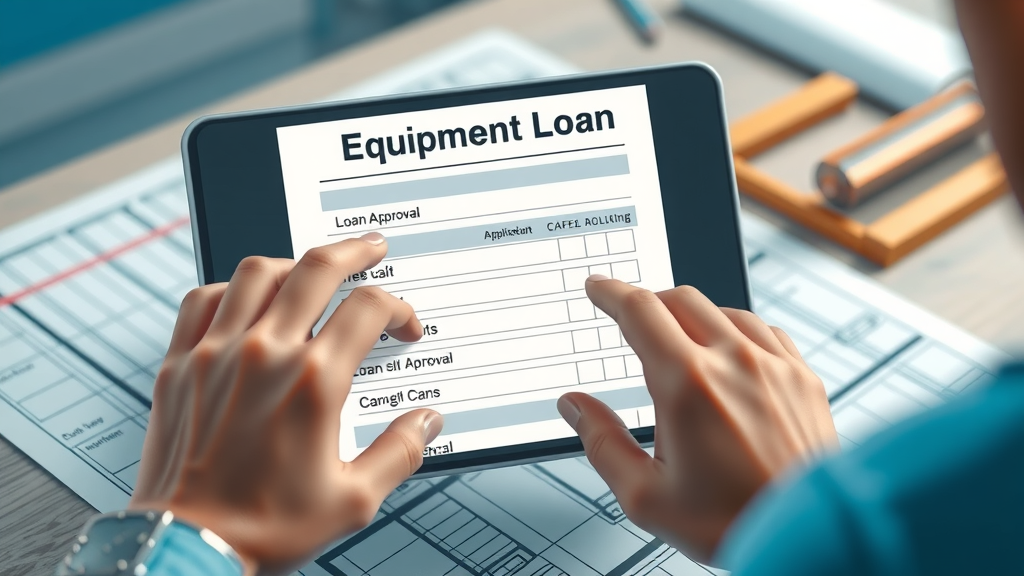Did you know that over 70% of all construction equipment purchases in the U.S. are financed rather than bought outright? This trend is reshaping how construction businesses operate, fueling growth, and expanding project possibilities. In this comprehensive guide, you’ll discover how construction equipment financing can become the key to boosting productivity and enabling your company to compete in an ever-evolving industry. Read on to understand your best loan options, learn approval steps, and see real-world outcomes—so you can take action with confidence.
Startling Trends in Construction Equipment Financing: What You Need to Know
The construction equipment financing landscape has changed dramatically in recent years, offering businesses faster, more strategic access to heavy equipment and machinery. What’s truly surprising is that financing—not outright purchase—has become the norm for over 70% of all construction-related acquisitions in the United States. This reflects both the rising cost of industrial equipment and the need for companies to preserve cash flow while remaining competitive.
Large contractors and small construction business owners alike now rely on a wide range of financing solutions to support project timelines, bid competitively, and keep machinery up-to-date. Lenders provide capital for equipment through loans, equipment leasing, or in-house manufacturer finance programs. The result is a powerful shift: contractors can bid on larger projects and scale their operations without draining reserves, while keeping monthly payments manageable.
As lending models evolve, more small business operators are discovering they can qualify for special programs—even if their credit isn’t perfect—by working with lenders who understand the industry. These trends all highlight why construction equipment financing is no longer just an option for large companies. It’s the proven path to growth for businesses of all sizes.

"Did you know? Over 70% of all construction equipment purchases in the U.S. are financed rather than bought outright—a growing trend fueling productivity and business growth."
What You'll Learn About Construction Equipment Financing
How construction equipment financing works for businesses
Key steps to secure equipment loans or financing solutions
Minimum credit requirements and lender expectations
How heavy equipment financing differs from other options
Answers to frequently asked questions from small business owners
How to choose the best construction equipment financing for your company
Understanding Construction Equipment Financing Options
Construction equipment financing provides businesses with the flexibility to acquire essential machinery—whether they need one piece or a fleet—without tying up working capital. There are two dominant models: equipment financing (i.e., loans) and equipment leasing. These solutions support a wide range of business goals, from long-term asset acquisition to responding to seasonal demand spikes. Choosing between them depends on your cash flow, project pipeline, and technology needs.
Equipment financing lets you purchase equipment outright, resulting in asset ownership and often favorable tax benefits. Equipment leasing, on the other hand, enables companies to acquire the latest technology with lower upfront costs, ideal for industries where rapid obsolescence is a concern. Specialized lenders and manufacturers offer tailored terms to match your equipment cost, loan amount, and project needs, all while enabling manageable monthly payments designed for construction cash cycles.
Equipment Financing vs. Equipment Leasing: Which Is Right for Your Business?
Choosing between equipment financing and equipment leasing is critical for construction companies aiming to maximize value and operational flexibility. An equipment loan provides ownership at the end of the term, typically with moderate upfront costs and lower long-term expenses. This model suits companies planning to use machines for several years or seeking eventual asset ownership and full tax benefit advantages.
In contrast, equipment leasing is optimal for businesses with temporary projects, frequent equipment upgrades, or limited initial capital. While leases offer lower upfront costs and the ability to swap machinery quickly, they usually come with higher ongoing payments and no ownership at term end. Carefully weigh your company’s individual situation, including cash flow and technology goals, before deciding on the best approach for your construction equipment needs.
Option |
Best for |
Ownership |
Upfront Costs |
Flexibility |
|---|---|---|---|---|
Equipment Financing |
Long-term asset use |
Yes (at term end) |
Moderate |
Lower |
Equipment Leasing |
Short-term needs, rapid upgrades |
No |
Low |
Higher |
Types of Equipment Loans for Construction Equipment
Today’s market offers a variety of equipment loan and financing solutions tailored for the construction industry. You can opt for traditional bank-funded loans, which provide competitive rates and longer terms, although they often require strong credit and detailed financial statements. Heavy equipment financing is designed for high-value assets—cranes, excavators, bulldozers—offering larger loan amounts and unique collateral terms.
Small business owners might also explore vendor financing programs, where equipment manufacturers provide financing directly—often packaging the transaction for speed and convenience. Lastly, operating leases allow you to “rent” construction equipment by the month or project, only paying for its use without impacting your balance sheet. Your choice will depend on your cash position, future plans, and eligibility for small business finance programs.
Traditional equipment loan
Heavy equipment financing
Small business loans
Vendor financing programs
Operating leases

Key Benefits of Construction Equipment Financing for Small Business Owners
For small business contractors, construction equipment financing can be a game-changer. Traditional capital investments in industrial equipment drain resources, but with financing and leasing, you preserve working capital for payroll, materials, and emergencies. This ensures projects move forward without jeopardizing your company’s financial health.
Monthly payments through an equipment loan also smooth cash flow, making large machinery purchases—and unexpected upgrades—manageable. Access to heavy equipment via financing means your business can expand into new markets, win larger contracts, and keep up with fast-moving technology advances. Ultimately, financing gives small construction companies greater business agility, enabling them to thrive—even in competitive environments.
"Construction equipment financing can unlock growth for small business operators, giving them immediate access to the heavy equipment they need to compete and thrive."
Preserve working capital
Keep equipment up-to-date
Support business expansion
Improve cash flow management
How to Get Approved for Construction Equipment Financing
Securing construction equipment financing requires preparation, but the process is simpler than many expect. Lenders focus on your business’s creditworthiness, the projected value of the equipment, and your history of managing monthly payments. Many providers offer specialized programs for the construction industry, making it easier for small business owners, even those without a perfect credit history, to apply.
To get started, outline your equipment needs—know what you need, why, and how it fits in your growth plans. Next, gather your financial statements and check both your business and personal credit scores. A strong application, backed by clear revenue records and responsible credit use, improves your approval chances. With financing in place, you’ll access capital for equipment without delay, supporting your company’s momentum.
Step-by-Step Guide to Securing an Equipment Loan or Lease
Moving from interest to approval for an equipment loan or lease is a straightforward process when you follow these steps. Begin by pinpointing the specific construction machinery your project or company requires—detail model, age (new or used), and cost estimates. Next, collect all necessary financial records, such as balance sheets and tax filings. Research lenders that specialize in equipment lending for the construction sector; read reviews emphasizing customer service and lend-approval timelines.
Once you’ve chosen a lender, submit a detailed application for either an equipment loan or lease. Carefully review the terms offered—not just interest rates, but repayment flexibility, collateral requirements, and any small business program eligibility. Upon acceptance, sign your agreement, coordinate with vendors, and arrange for equipment delivery. This systematic approach turns what can seem overwhelming into an efficient path to equipment financing.
Determine the construction equipment your business needs
Collect financial statements and review credit score
Select an equipment financing provider or lender
Submit your application for an equipment loan or lease
Review and accept financing terms
Take delivery of your new or used equipment

Financial Statement Requirements and Lender Expectations
Lenders use financial statements to test whether your company will reliably make monthly payments on a substantial equipment loan. You should gather current and past balance sheets, income statements, and at least two years of business tax returns. Most lenders want to see a minimum business credit score between 600-650, though there are exceptions for businesses with strong cash flow or collateral.
Personal credit scores may also be considered, particularly for smaller firms and small business owners. Be prepared to explain any dips in revenue, short-term losses, or other red flags in your documents. Good preparation here will significantly ease the credit decision process and enable your lender to offer the best equipment financing solution for your situation.
Balance sheet and income statements
Business tax returns (last 2 years)
Personal and business credit scores
Top Lenders and Providers for Construction Equipment Financing
Your choice of lender plays a major role in shaping your construction equipment financing success. There are several common provider categories: national banks with expansive equipment finance arms and robust compliance standards (often member FDIC and equal housing lenders), online lenders offering rapid approval and funding, and industry-specific equipment manufacturers with in-house financing.
Regional banks and credit unions may offer specialized small business programs, sometimes with more personal customer support. Carefully review your lender’s expertise in heavy equipment financing, their reputation for clear credit decisions, and whether they provide flexible loan terms or creative solutions. Balancing speed, support, and cost enables your business to maximize every financing opportunity and keep growth on track.
National banks specializing in equipment finance
Online lenders offering fast approval
Equipment manufacturers with in-house financing solutions
Credit unions and regional banks
Heavy Equipment Financing: Unique Factors and Opportunities
Heavy equipment financing isn’t just a bigger version of traditional equipment loans. Massive machinery, such as earthmovers, bulldozers, and tower cranes, means larger loan amounts, extended repayment periods, and customized collateral agreements. These factors can be advantageous for construction companies eyeing expansion, modernization, or new markets.
Because heavy equipment financing involves such high investment, working with providers who have deep industry knowledge is essential. They can tailor solutions that integrate with your cash flow and project cycles. Specialized lenders often offer flexible terms, such as seasonal payments or deferrals during slow periods, giving your business vital agility as you take on complex contracts. Investing in heavy equipment via financing positions your company for lasting growth and sharp competitiveness.
Choosing the Right Heavy Equipment Financing for Growth
To maximize the benefits of heavy equipment financing, construction companies should look for lenders who offer expertise beyond simple funding. You want a partner that understands equipment depreciation, resale values, and project-based income streams. Longer repayment terms and more substantial loan amounts are standard for industrial equipment—but the best providers also bring tailored collateral requirements and consultative service to the table.
Lenders with industry-specific experience will work with your individual situation to structure payments and terms that match your growth trajectory, ensuring your access to capital doesn’t become a bottleneck. Whether you’re scaling a crew, entering a new region, or modernizing your toolkit, having the right equipment finance partner can make all the difference between missed opportunities and rapid business growth.
"Heavy equipment financing provides unique leverage in industries with high capital expenditures—enabling companies to scale, modernize, and remain competitive."
Longer repayment terms
Larger loan amounts
Collateral requirements
Specialized lender expertise

Construction Equipment Financing Solutions: Real-World Case Studies
Seeing how construction equipment financing works in practice offers powerful proof for business owners on the fence. Consider this: a growing regional contractor wanted to double project size but lacked upfront capital for a new crane and excavator. Through a fast-tracked equipment loan, the company preserved cash flow, secured better contracts, and expanded staff.
The investment didn’t just boost capacity—it delivered a measurable ROI within months as the contractor was able to take on previously unattainable work. Another case saw a small business utilize vendor finance corp programs to update their aging vehicle fleet, resulting in lower maintenance costs and increased customer wins. The right financing solutions unlocked opportunities both obvious and unexpected.
Case Study: Small Business Expands Operations Through Equipment Financing
By leveraging construction equipment financing, a small but ambitious contractor was able to transform its growth trajectory. The firm accessed an equipment finance line from a trusted lender, allowing immediate procurement of specialized machinery. This directly enabled them to bid on—and win—larger contracts, diversify services, and employ more local workers.
Within one year, revenue doubled. The strategic use of equipment financing didn’t just fulfill a momentary need, but permanently scaled the business. This story is proof that with the right financing partner and a clear plan, small businesses in the construction sector can achieve outsized results.
"Access to construction equipment financing allowed our firm to win bigger contracts and double our revenue within a year." – Small Business Owner

How to Choose the Best Construction Equipment Financing Partner
Comparing providers is the key to finding the optimal construction equipment financing solution for your business. Focus on more than just the lowest interest rate: evaluate lender reputation, industry experience, and customer service feedback. Carefully review each offer’s repayment terms—flexibility can be just as important as overall cost for companies with variable project schedules.
Don’t overlook eligibility for special small business or equipment finance corp programs. These may include lower down payments, easier qualification based on equipment value or monthly payments, and additional perks like deferred payments during off-seasons. A provider with a strong track record in heavy equipment financing will offer resources and advice tailored for construction businesses, not just generic loans. Make your decision based on both the financial details and the relationship support your lender provides.
Compare interest rates and loan terms
Evaluate customer service and industry reputation
Review flexibility on repayment schedules
Check eligibility for small business programs
People Also Ask: Construction Equipment Financing FAQs
How to get a loan for construction equipment?
To get a loan for construction equipment, start by identifying the specific equipment and its expected cost. Prepare your company’s financial statements, making sure both business and personal credit scores are up-to-date. Then, research and approach lenders who specialize in equipment financing, since they understand the nuances of construction equipment cost and project timelines. Many providers have pre-approval processes online, making it easy for you to quickly discover your potential loan amount and terms before submitting a complete application.

How hard is it to get equipment financing?
Securing equipment financing is generally easier compared to traditional bank loans. Approval mainly depends on your company’s credit score, the health of your financial statements, and the value of both the equipment and any offered collateral. Many lenders cater to small business owners with flexible criteria, streamlined credit decisions, and faster application review, enabling a broader range of construction companies to access the funds needed for business growth.
What is the minimum credit score for equipment financing?
Most construction equipment financing providers require a minimum credit score of 600–650. However, some will work with applicants whose scores fall below this range if strong collateral or larger down payments are available. Lower-credit applicants should expect slightly higher interest rates or adjusted terms, but many lenders offer ways forward for companies with a solid business plan and demonstrated revenue.
Who has the best equipment financing?
The best equipment financing partner for your business depends on company size, project scope, and your preferred loan terms. National banks (member FDIC, equal housing lender), specialized equipment finance firms, and direct manufacturer finance programs all provide excellent options. Take the time to compare offers for interest rates, terms, and customer service quality before choosing your provider.
Frequently Asked Questions About Construction Equipment Financing
Can I get construction equipment financing for used equipment?
What documentation is required for an equipment loan?
Are there tax advantages to financing heavy equipment?
How quickly can I get approved for construction equipment financing?
Key Takeaways: Construction Equipment Financing for Small Business
Most construction businesses use equipment financing to stay competitive
Both equipment loans and leases are valuable financing solutions
Choosing the right lender and solution depends on your business’s size and needs
Conclusion: Empowering Your Construction Business with Equipment Financing
Construction equipment financing can be the key to rapid growth and success—unlocking access to the machinery your business needs while protecting cash flow.
Ready to Finance Your Construction Equipment? Take the Next Step
Email us at: 3daybizloan@gmail.com to discuss your needs, learn about equipment financing options, and get a personalized quote.
 Add Row
Add Row  Add
Add 



Write A Comment